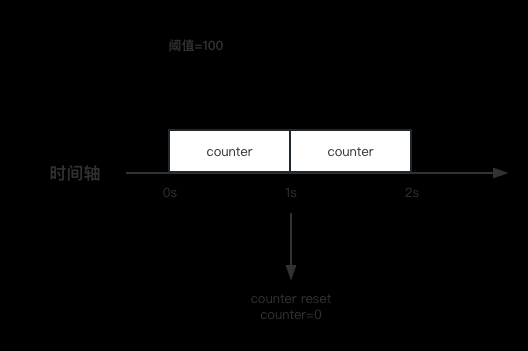思路:通过AOP拦截注解标记的方法,在Redis中维护一个计数器来记录接口访问的频率,
并根据限流策略来判断是否允许继续处理请求。
另一篇:springboot 自定义注解 ,aop切面@Around; 为接口实现日志插入【强行喂饭版】
不多说,直接上代码:
一:创建限流类型
/**
* 限流类型
*
*/
public enum LimitType
{
/**
* 默认策略全局限流
*/
DEFAULT,
/**
* 根据请求者IP进行限流
*/
IP
}
二:创建注解
import 你上面限流类型的路径.LimitType;
import java.lang.annotation.*;
/**
* 限流注解
*
*/
// 注解的作用目标为方法
@Target(ElementType.METHOD)
// 注解在运行时保留,编译后的class文件中存在,在jvm运行时保留,可以被反射调用
@Retention(RetentionPolicy.RUNTIME)
// 指明修饰的注解,可以被例如javadoc此类的工具文档化,只负责标记,没有成员取值
@Documented
public @interface LimiterToShareApi{
/**
* 限流key
*/
public String key() default "";
/**
* 限流时间,单位秒
*/
public int time() default 60;
/**
* 限流次数
*/
public int count() default 100;
/**
* 限流类型,默认全局限流
*/
public LimitType limitType() default LimitType.DEFAULT;
}
**三:编写业务异常类 **
/**
* 业务异常
*
*/
public final class ServiceException extends RuntimeException
{
// 序列化的版本号的属性
private static final long serialVersionUID = 1L;
/**
* 错误码
*/
private Integer code;
/**
* 错误提示
*/
private String message;
/**
* 空构造方法,避免反序列化问题
*/
public ServiceException(){
}
/**
* 异常信息
*/
public ServiceException(String message){
this.message = message;
}
}
四:实现aop切面拦截,限流逻辑处理
import 你上面限流类型的路径.LimitType;
import 你上面业务异常的路径.ServiceException;
import 你上面限流注解的路径.LimiterToShareApi;
import org.aspectj.lang.JoinPoint;
import org.aspectj.lang.annotation.Aspect;
import org.aspectj.lang.annotation.Before;
import org.aspectj.lang.reflect.MethodSignature;
import org.slf4j.Logger;
import org.slf4j.LoggerFactory;
import org.springframework.beans.factory.annotation.Autowired;
import org.springframework.core.annotation.Order;
import org.springframework.data.redis.core.RedisTemplate;
import org.springframework.data.redis.core.script.RedisScript;
import org.springframework.stereotype.Component;
import java.lang.reflect.Method;
import java.util.Collections;
import java.util.List;
// 声明这是一个切面类
@Aspect
// 表明该类是一个组件,将该类交给spring管理。
@Component
// 指定执行顺序,值越小,越先执行。限流策略一般最先执行。
@Order(1)
public class LimiterToShareApiAspect {
// 记录日志的Logger对象
private static final Logger log = LoggerFactory.getLogger(LimiterToShareApiAspect.class);
// 操作Redis的RedisTemplate对象
private RedisTemplate<Object, Object> redisTemplate;
//在Redis中执行Lua脚本的对象
private RedisScript<Long> limitScript;
@Autowired
public void setRedisTemplate1(RedisTemplate<Object, Object> redisTemplate) {
this.redisTemplate = redisTemplate;
}
@Autowired
public void setLimitScript(RedisScript<Long> limitScript) {
this.limitScript = limitScript;
}
// 这个注解作用及普及 见文章后面解析
@Before("@annotation(limiter)")
public void doBefore(JoinPoint point, LimiterToShareApi limiter) throws Throwable {
// 根据业务需求,看看是否去数据库查询对应的限流策略,还是直接使用注解传递的值
// 这里演示为 获取注解的值
int time = limiter.time();
int count = limiter.count();
String combineKey = getCombineKey(limiter, point);
List<Object> keys = Collections.singletonList(combineKey);
try {
Long number = redisTemplate.execute(limitScript, keys, count, time);
if (number == null || number.intValue() > count) {
throw new ServiceException("限流策略:访问过于频繁,请稍候再试");
}
log.info("限制请求'{}',当前请求'{}',缓存key'{}'", count, number.intValue(), combineKey);
} catch (ServiceException e) {
throw e;
} catch (Exception e) {
throw new RuntimeException("服务器限流异常,请稍候再试");
}
}
/**
* 获取用于限流的组合键,根据LimterToShareApi注解和JoinPoint对象来生成。
*
* @param rateLimiter LimiterToShareApi注解,用于获取限流配置信息。
* @param point JoinPoint对象,用于获取目标方法的信息。
* @return 生成的用于限流的组合键字符串。
*/
public String getCombineKey(LimiterToShareApi rateLimiter, JoinPoint point) {
// 创建一个StringBuffer用于拼接组合键
StringBuffer stringBuffer = new StringBuffer(rateLimiter.key() + "-");
// 根据LimterToShareApi注解的limitType判断是否需要添加IP地址信息到组合键中【判断限流类型 是否根据ip进行限流】
if (rateLimiter.limitType() == LimitType.IP) {
// 如果需要添加IP地址信息,调用IpUtils.getIpAddr()方法获取当前请求的IP地址,并添加到组合键中
stringBuffer.append(getClientIp()).append("-");
}
// 使用JoinPoint对象获取目标方法的信息
MethodSignature signature = (MethodSignature) point.getSignature();
Method method = signature.getMethod();
Class<?> targetClass = method.getDeclaringClass();
// 将目标方法所属类的名称和方法名称添加到组合键中
stringBuffer.append(targetClass.getName()).append("-").append(method.getName());
// 返回生成的用于限流的组合键字符串
return stringBuffer.toString();
}
/**
* 获取调用方真实ip [本机调用则得到127.0.0.1]
* 首先尝试从X-Forwarded-For请求头获取IP地址,如果没有找到或者为unknown,则尝试从X-Real-IP请求头获取IP地址,
* 最后再使用request.getRemoteAddr()方法作为备用方案。注意,在多个代理服务器的情况下,
* X-Forwarded-For请求头可能包含多个IP地址,我们取第一个IP地址作为真实客户端的IP地址。
*/
public String getClientIp() {
HttpServletRequest request = ((ServletRequestAttributes) RequestContextHolder.currentRequestAttributes()).getRequest();
String ipAddress = request.getHeader("X-Forwarded-For");
if (ipAddress == null || ipAddress.length() == 0 || "unknown".equalsIgnoreCase(ipAddress)) {
ipAddress = request.getHeader("X-Real-IP");
}
if (ipAddress == null || ipAddress.length() == 0 || "unknown".equalsIgnoreCase(ipAddress)) {
ipAddress = request.getRemoteAddr();
}
// 多个代理服务器时,取第一个IP地址
int index = ipAddress.indexOf(",");
if (index != -1) {
ipAddress = ipAddress.substring(0, index);
}
return ipAddress;
}
}
五:哪里需要点哪里
@PostMapping("/接口api")
// 根据自己业务选择是否需要这些参数,如果是想从数据库读取,不填参数即可
// 这里意思为对key的限制为 全局 每60秒内2次请求,超过2次则限流
@LimiterToShareApi(key = "key",time = 60,count = 2,limitType = LimitType.DEFAULT)
public AjaxResult selectToUserId(参数){}
限流(代码)结果:


解析:文章来源:https://www.toymoban.com/news/detail-609972.html
@Before("@annotation(limiter)"):
- 使用了@Before 来表示这是一个切面注解,用于定义在目标方法执行前执行的逻辑
- @annotation(limiter) 中的limiter是指参数名称,而不是注解名称。
- @annotation(limiter) 中的limiter参数类型为LimiterToShareApi,
表示你将拦截被@LimiterToShareApi注解标记的方法,并且可以通过这个参数来获取@LimiterToShareApi注解的信息。
如果你想拦截其他注解,只需将第二个参数的类型修改为对应的注解类型即可。
普及:文章来源地址https://www.toymoban.com/news/detail-609972.html
JoinPoint是Spring AOP中的一个接口,它代表了在程序执行过程中能够被拦截的连接点(Join Point)。
连接点指的是在应用程序中,特定的代码块,比如方法的调用、方法的执行、构造器的调用等。
JoinPoint在AOP中的作用是用于传递方法调用的信息,比如方法名、参数、所属的类等等。
当AOP拦截到一个连接点时,就可以通过JoinPoint对象来获取这些信息,并根据需要进行相应的处理。
在AOP中,常见的通知类型(advice)如下:
@Before:在目标方法执行之前执行。
@After:在目标方法执行之后(无论是否抛出异常)执行。
@AfterReturning:在目标方法成功执行之后执行。
@AfterThrowing:在目标方法抛出异常后执行。
@Around:在目标方法执行前后都执行,可以控制目标方法的执行。
在以上各种通知中,可以使用JoinPoint参数来获取连接点的相关信息。
例如,在@Around通知中,可以使用JoinPoint对象来获取目标方法的信息,
比如方法名、参数等。这样,我们就可以根据这些信息来实现我们需要的切面逻辑。
eg:
// 获取方法名
String methodName = joinPoint.getSignature().getName();
//获取方法参数
Object[] args = joinPoint.getArgs();
// 获取所属类名
String className = joinPoint.getSignature().getDeclaringTypeName();
// 获取源代码位置信息
SourceLocation sourceLocation = joinPoint.getSourceLocation();
到了这里,关于springboot 自定义注解 ,实现接口限流(计数器限流)【强行喂饭版】的文章就介绍完了。如果您还想了解更多内容,请在右上角搜索TOY模板网以前的文章或继续浏览下面的相关文章,希望大家以后多多支持TOY模板网!











